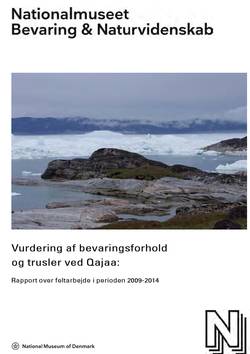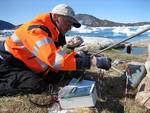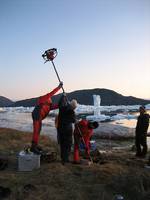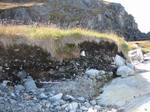Climate Change and Kitchen Middens – when the Permafrost disappears
Increasing temperatures around Greenland reduces the permafrost and previously frozen sites thaw, which may lead to decay of organic material. The project will investigate the effect on the preservation conditions for middens along the Disko Bay and compare the decay rate in the past, present and in the future. The main goal is to develop mitigation strategies to reduce the decay of the middens.
Coordinator: Henning Matthiesen, Bevaringsafdelingen
Other participants:
PhD Jørgen Hollesen
Conservator Jan Bruun Jensen
The Etnographis Department at the Danish National Museum
Institute of Geography, University of Copenhagen
The Greenlandic National Museum
The Danish Zoological Museum
The project was carried out from 2009 to 2014
Article on Videnskab.dk
Arkæologisk guldgrube smelter væk på Grønland (Article in Danish)
Field work report 2009-2014 (in Danish)
Nationalmuseets Arbejdsmark 2012
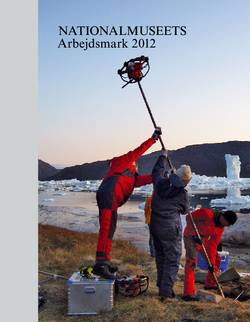
Qajaa i Vestgrønland - frossen fortid i en varm fremtid (Article in Danish only)
The Frozen Past
The department of preservation at the Danish National Museum is investigating how climate changes affect the permafrozen archaeological contexts at the Qajaa settlement in Greenland. The project is a part of the large research initiative "Northern Worlds" at the museum and in a close collaboration with the Greenlandic National Museum & Archives.
One Year at Qajaa
Once a day at noon from August 2010 until July 2011 a camera has been set to automatically take a photo. The photos has been collected in a movie that uniquely shows how the conditions change over the seasons at Qajaa.
Winter Expedition to Qajaa 2011
In February 2011 two of the researchers from the Danish National Museum went to visit the settlement at Qajaa during the winter. The purpose was to control the automatic camera installed on site, to collect data from the camera, and collect data about the snow and ice conditions. The expedition was carried out by boat and dog sledge. In spite of -25°C the expedition used tents for the camping, and that resulted in experiencing the most beautiful sun rise one could ever imagine.


